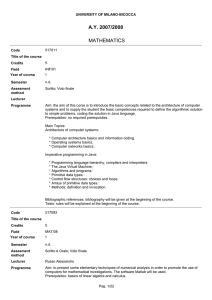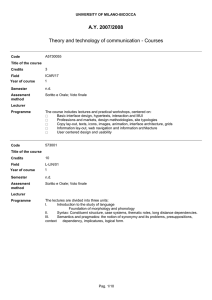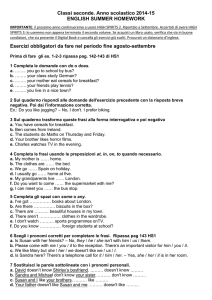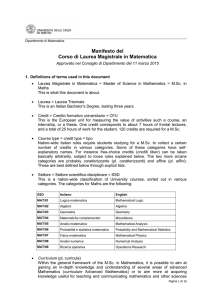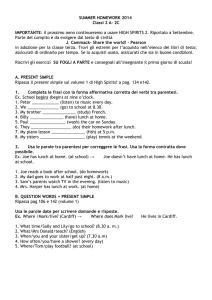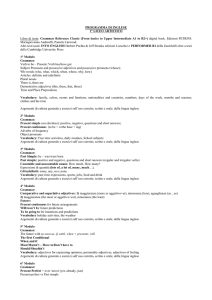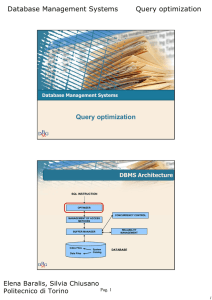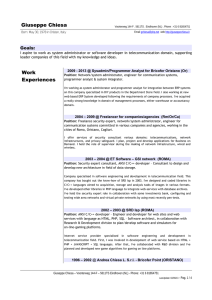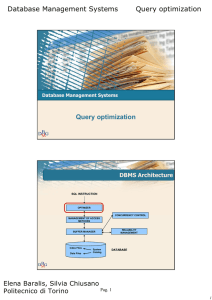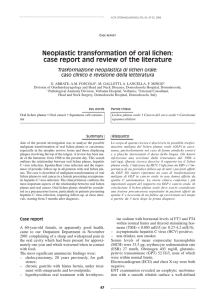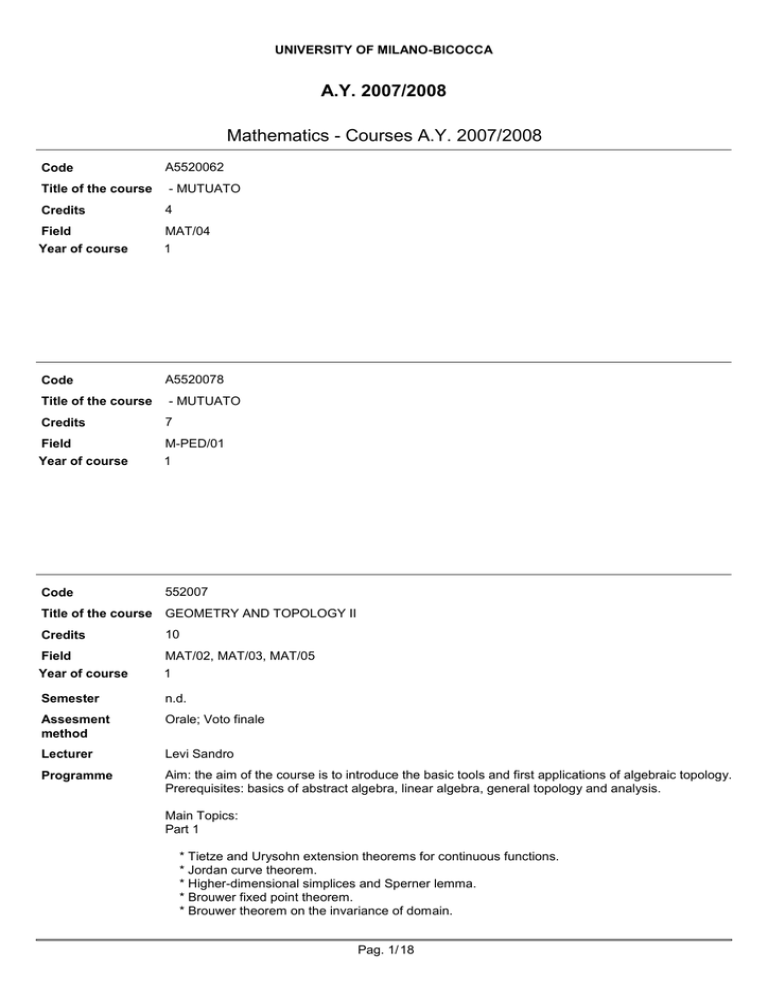
UNIVERSITY OF MILANO-BICOCCA
A.Y. 2007/2008
Mathematics - Courses A.Y. 2007/2008
Code
A5520062
Title of the course
- MUTUATO
Credits
4
Field
Year of course
MAT/04
1
Code
A5520078
Title of the course
- MUTUATO
Credits
7
Field
Year of course
M-PED/01
1
Code
552007
Title of the course
GEOMETRY AND TOPOLOGY II
Credits
10
Field
Year of course
MAT/02, MAT/03, MAT/05
1
Semester
n.d.
Assesment
method
Orale; Voto finale
Lecturer
Levi Sandro
Programme
Aim: the aim of the course is to introduce the basic tools and first applications of algebraic topology.
Prerequisites: basics of abstract algebra, linear algebra, general topology and analysis.
Main Topics:
Part 1
* Tietze and Urysohn extension theorems for continuous functions.
* Jordan curve theorem.
* Higher-dimensional simplices and Sperner lemma.
* Brouwer fixed point theorem.
* Brouwer theorem on the invariance of domain.
Pag. 1/ 18
Part 2
* Basic notions of algebraic topology.
* Fundamental group and coverings.
* Time permitting: homology (singular and/or simplicial).
Bibliographic references:
J. Dugundji, Topology, Allyn and Bacon, 1966.
J. Van Mill, Infinite-dimensional topology: prerequisites and introduction, North-Holland Mathematical
Library, 1988.
E. Sernesi, Geometria 2, Bollati Boringhieri, 1994.
C. Kosniowski, Introduzione alla topologia algebrica, Zanichelli, 1988.
Additional bibliography and notes will be available during the course.
Tests: oral test.
Code
552009
Title of the course
PHYSICAL THEORIES AND MATHEMATICAL MODELS
Credits
10
Field
Year of course
1
Semester
n.d.
Assesment
method
Scritto e Orale; Voto finale
Lecturer
Russo Alessandro
Programme
Aim: to present and discuss the basic equations that govern fluid motion in the case of ideal and
viscous conditions, for incompressible and compressible fluid flows, with or without vorticity. To
discuss the most important solutions for the cases considered. To solve numerically the equations
for fluid flows (after some simplifications).
Prerequisites: --.
INF/01, MAT/07, MAT/08
Main Topics:
Programme of the theoretical part.
Elements of kinematics of fluid flows: continuum hypothesis; Eulerian/Lagrangian description;
invariants of motion. Fundamentals: mass conservation; rotation and vorticity; conservation of linear
momentum; Jacobian and incompressibility; conservation of energy. Euler's equations: Bernoulli's
theorem; Kelvin's circulation theorem; vorticity transport theorem; Helmholtz's conservation laws;
Cauchy's solutions and topological equivalence classes; case of incompressible flow in two
dimensions; fluid flow decomposition; vortex filament and self-induction; kinetic energy, linear and
angular momentum and helicity of vortices. Navier-Stokes' equations: Reynolds' number; Stokes'
flows; dissipation of kinetic energy; Poisuille's flow; example of boundary layer modelling.
Compressibility and waves in one dimension: the wave equation; representation of d'Alambert 's
solution on the (x,t)-plane; conservation laws in the presence of discontinuities; contact
discontinuities and shock wave; separation of the characteristics and entropic condition; convexity
criterium for the classification of the discontinuities.
Programme of the Applied part.
Introduction to the numerical approximation of the equations describing fluid flows; finite differences
and finite elements; examination in simplified cases of the numerical difficulties involved.
Bibliographic references: G.K. Batchelor, An Introduction to Fluid Dynamics, Cambridge University
Press, 1967.
A.J. Chorin, J.E. Marsden, A Mathematical Introduction to Fluid Mechanics, Springer-Verlag, 1990.
P.G. Saffman, Vortex Dynamics, Cambridge University Press, 1991.
M. Van Dyke, An Album of Fluid Motion, The Parabolic Press, 1982.
The course notes will be made available.
Tests: report on the laboratory activities and oral test.
Pag. 2/ 18
Code
517082
Title of the course
- CONDIVISO DA 517
Year of course
n.d.
Code
517081
Title of the course
- CONDIVISO DA 517
Year of course
n.d.
Code
517075
Title of the course
- CONDIVISO DA 517
Year of course
n.d.
Code
517080
Title of the course
- CONDIVISO DA 517
Year of course
n.d.
Pag. 3/ 18
Code
516085
Title of the course
- MUTUATO
Credits
6
Field
Year of course
INF/01
n.d.
Code
561005
Title of the course
- MUTUATO
Credits
6
Field
Year of course
SECS-S/01
n.d.
Code
561009
Title of the course
- MUTUATO
Credits
6
Field
Year of course
SECS-P/01
n.d.
Code
561010
Title of the course
- MUTUATO
Credits
6
Field
Year of course
SECS-P/01
n.d.
Pag. 4/ 18
Code
552010
Title of the course
Credits
7
Field
Year of course
FIS/08
n.d.
Semester
n.d.
Assesment
method
Orale; Voto finale
Lecturer
Lucchini Gianni
Programme
Aim: the course is aimed to:
a deeper knowledge of items in classical and modern physics already met in the general physics
courses;
a first look to laboratory methods and experimental data analysis.
Prerequisites: --.
Main Topics:
not available at the publication date.
Bibliographic references: bibliography will be given at the beginning of the course.
Tests: rules will be explained at the beginning of the course.
Code
517077
Title of the course
- CONDIVISO DA 517
Year of course
n.d.
Code
561013
Title of the course
- MUTUATO
Credits
6
Field
Year of course
SECS-S/01
n.d.
Pag. 5/ 18
Code
561015
Title of the course
- MUTUATO
Credits
6
Field
Year of course
SECS-S/01
n.d.
Code
516146
Title of the course
- MUTUATO
Credits
6
Field
Year of course
INF/01
n.d.
Code
A5520059
Title of the course
- MUTUATO
Credits
4
Field
Year of course
MAT/04
n.d.
Code
A5520061
Title of the course
- MUTUATO
Credits
6
Field
Year of course
SECS-P/01
n.d.
Pag. 6/ 18
Code
A5520079
Title of the course
Advanced geometry
Credits
5
Field
Year of course
MAT/03
n.d.
Semester
n.d.
Assesment
method
Scritto; Voto finale
Lecturer
Paoletti Roberto
Programme
Aim: this corse aims to take a closer look at the notion of differentiable manifold, with a special
emphasis to the relation between vector fields and diffeomorphisms.
Prerequisites: basic differential topology.
Main Topics:
* Differentiable manifold.
* Partitions of unity.
* Vector fields and diffeomorphisms.
* Integrability and the theorem of Frobenius.
* Introduction to the theory of Lie groups.
The theory will be illustrated by several examples, largely inspired from the theory of Lie groups.
Bibliographic references:
Teacher's notes.
Tests: written test.
Code
A5520054
Title of the course
Functional Analysis
Credits
7
Field
Year of course
MAT/05
n.d.
Semester
n.d.
Assesment
method
Orale; Voto finale
Lecturer
Meda Stefano
Programme
Aim: this course on the Theory of Distributions, with applications to partial differential equations.
Prerequisites: --.
Main Topics:
* Locally convex topologies.
* Tempered distributions.
* Distributions.
* Introduction to Sobolev spaces.
Bibliographic references: notes will be distributed during the course.
Tests: oral test.
Pag. 7/ 18
Code
552005
Title of the course
General Relativity - MUTUATO
Credits
5
Field
Year of course
FIS/02
n.d.
Code
A5520081
Title of the course
HARMONIC ANALYSIS
Credits
7
Field
Year of course
MAT/05
n.d.
Semester
n.d.
Assesment
method
Orale; Voto finale
Lecturer
Kuhn Maria gabriella
Programme
Aim: --.
Prerequisites: --.
Main Topics:
not available at the publication date.
Bibliographic references: the course notes will be made available.
Tests: oral test.
Code
552012
Title of the course
HISTORY OF MATHEMATICS
Credits
8
Field
Year of course
MAT/04
n.d.
Semester
n.d.
Assesment
method
Orale; Voto finale
Lecturer
Colzani Leonardo
Programme
Aim: The aim of the course is to introduce a certain number of mathematical topics in a historical
perspective.
Prerequisites: --.
Main Topics:
The problem of the squaring of the circle and of the hyperbola and the numbers pi and e. The
lunulae of Hyppocrates. Archimedes and the method of exhaustion. Tables of chords and
logarithms. Wallis infinite product. Gregory-Leibniz arc tangent series. Euler series of the inverses of
squares. Lagrange and continued fractions. Buffon and Monte Carlo methods. Gauss circle problem.
The lemniscate and the arithmetic geometric means. The catenary and the isoperimetric problem.
The cycloid. Rational, algebraic and transcendental numbers. Ruler, compasses, origami. An
abstract definition of pi.
Pag. 8/ 18
Bibliographic references:
bibliography will be given at the beginning of the course.
Tests: oral test.
Code
A5520068
Title of the course
Homological Algebra
Credits
7
Field
Year of course
MAT/02
n.d.
Semester
n.d.
Assesment
method
Scritto e Orale; Voto finale
Lecturer
Weigel Thomas stefan
Programme
Aim: one on the central subjects in homological algebra is the study of the modules of a ring R. For
two R-modules M and N one can define abelian groups ExtkR(M,N) which are derived forms of the
abelian group HomR(M,N). For groups - but also for other algebraic or geometric structure - these
groups reflect many combinatorical or geometric properties. In the course we intend to develop the
theory far enough in order to apply it to groups which act on trees.
Prerequisites: Algebra I e II mod.
Main Topics:
* Rings, modules and complexes of modules.
* The abelian group HomR(M,N).
* Projective modules, projective resolutions and the bar complex.
* The comparison theorem.
* The abelian groups ExtkR(M,N) and cohomology.
* Generators of a group, the Cayley graph of a group.
* Free groups and groups acting on trees.
Bibliographic references:
K.S. Brown, Cohomology of Groups, Graduate Texts in Mathematics, vol. 87, Springer-Verlag, 1982.
P.J. Hilton, U. Stammbach, A Course in Homological Algebra, Graduate Texts in Mathematics, vol.
4, second edition, Springer-Verlag, 1997.
S. MacLane, Homology, Classics in Mathematics, Springer-Verlag, 1975.
J-P. Serre, Trees, Springer-Verlag, 1980.
Exams: written and oral exams.
Code
552003
Title of the course
INTRODUCTORY QUANTUM MECHANICS - MUTUATO
Credits
5
Field
Year of course
FIS/02
n.d.
Pag. 9/ 18
Code
A5520077
Title of the course
NON LINEAR ANALYSIS
Credits
7
Field
Year of course
MAT/05
n.d.
Semester
n.d.
Assesment
method
Orale; Voto finale
Lecturer
Cellina Arrigo
Programme
Aim: to introduce the basic results in the Calculus of Variation.
Prerequisites: Analysis as presented in the first three years of classes. Analisi Funzionale ed
Equazioni Differenziali (Prof. Terracini).
Main Topics:
* Introduction to the Calculus of Variations. The Direct Method. Coercivity. Weak lower
semicontinuity.
* Bipolar of a function and relaxation.
* Euler Lagrange equations. The Pontriagin Maximum Principle and their relations.
Bibliographic references:
B. Dacorogna, Direct methods in the calculus of variations, Applied Mathematical Sciences,
Springer-Verlag, 1989.
Tests: oral test.
Code
A5520074
Title of the course
NUMBER THEORY AND CRYPTOGRAPHY
Credits
7
Field
Year of course
MAT/02
n.d.
Semester
n.d.
Assesment
method
Orale; Voto finale
Lecturer
Dalla volta Francesca
Programme
Aim: in this course, some algebraic and number theory arguments, foundamental for studying
asymmetric cryptosystems are studied.
Prerequisites: basic facts about algebraic structures, generally given in the first degree courses of
algebra.
Main Topics:
*
* Finite fields: Integer numbers and congruences. Finite fields. Euler's function. Remainder
Chinese Theorem.
* Prime numbers and factorization: Little Fermat's Theorem. Pseudoprime numbers and primality
tests (Fermat, Jacobi, Miller-Rabin), (p-1) Pollard method). Introduction to the complexity.
* Symmetric and asymmetric cryptographic systems: Public key cryptography (RSA. Diffie ed
Hellman Cryptosystem). The discrete logarithm problem.
* Elliptic curves: Weierstrass equation. The group of the points of an elliptic curve. Elliptic curves
on finite fields. Key exchange of Diffie-Hellmann, ElGamal's protocol.
Factorization using the elliptic curves: primality tests.
Pag. 10/ 18
Bibliographic references:
N. Koblitz, A course in Number Theory and Cryptography, volume 114 of Graduate texts in
Mathematics, Springer-Verlag, second edition, 1994.
A. Languasco, A. Zaccagnini, Introduzione alla Crittografia, Hoepli Editore, 2004.
L. C. Washington, Elliptic Curves, Number theory and Cryptography, Chapman&Hall/CRC, 2003.
Tests: oral test. (The students may prepare a talk, which is part of the test).
Code
A5520080
Title of the course
Real Analysis
Credits
5
Field
Year of course
n.d.
Semester
n.d.
Assesment
method
Orale; Voto finale
Lecturer
Varopoulos Nicolas
Programme
Aim:
Prerequisites: basic knowledge of measure theory and functional analysis. In particular, the
definition and the elementary properties of Lp spaces.
MAT/05
Main Topics:
* Definition of distributions and Fourier Transform: Plancherel's theory for L2(RN).
* Part I: notions from real variable theory. Vitali covering Lemma and Whitney decomposition.
Definition and first properties of the Hardy-Littlewood maximal function. Special cases of the
interpolation theorem in LP and the mapping properties of the Hardy-Littlewood maximal function.
* Part II: Singular Integrals. Calderon-Zygmund decomposition of a function. The definition and
the properties of the classical singular integrals.
* Part III: Differentiability properties. Riesz potentials and Sobolev spaces. Hardy-LittlewoodSobolev theorem.
* Part IV: Applications. Harmonic functions. Boundary behaviour (Fatou's theorem). Conjugate
harmonic functions in the classical case in dimension 1. Hp spaces. Extensions to higher
dimensions.
Bibliographic references:
W. Rudin, Real and Complex analysis, McGraw-Hill,1987.
E. Stein, G. Weiss, Introduction. Of Fourier Analysis on Euclidean spaces, Princeton University
Press, 1971.
E. Stein, Singular integrals and differentiability properties, Princeton University Press, 1970.
K. Hoffman, Banac spaces of analytic functions, Prentice Hall, 1962 (or Dover,1988).
Y. Katznelson, An introduction to harmonic analysis, Wiley, 1968 (or Dover, 1976).
Tests: oral test.
Pag. 11/ 18
Code
552008
Title of the course
Theory of Dynamical Systems
Credits
7
Field
Year of course
MAT/07
n.d.
Semester
n.d.
Assesment
method
Orale; Voto finale
Lecturer
Falqui Gregorio
Programme
Aim: the aim of the course is to discuss some fundamental aspects of the modern theory of
Hamiltonian dynamical systems. This will be done mostly from a geometrical point of view. We will
consider both "qualitative" aspects of the theory (e.g., the perturbation theory of integrable systems)
and methods for "exactly" solving Hamilton equations (e.g., the Hamilton-Jacobi theory and the Lax
scheme).
Prerequisites: --.
Main Topics:
* Hamiltonian Mechanics, completely integrable systems and Action-Angle variables.
* Oscillations: Introduction to perturbative techniques.
* Hamilton-Jacobi theory and Separation of Variables.
* Lax pairs: Toda and Calogero type systems.
* The Korteweg-de Vries equation as an infinite dimensional integrable system.
Bibliographic references: notes covering the greatest part of the course will be provided.
Additional references (for specific topics): V. I. Arnold, Metodi Matematici della Meccanica Classica,
Editori Riuniti, 2004.
A. Giorgilli, Dynamical Systems, Part I: Exponential stability of Hamiltonian systems. In: Dynamical
systems. Part I., Pubblicazioni Centro di Ricerca Matematica "Ennio De Giorgi".
B.A. Dubrovin, I.M. Krichever, S.P. Novikov, Integrable systems. In Dynamical systems, IV, 177-332, Encilopædia Mat. Sci., 4, Springer-Verlag, 2001.
A. Fasano, S. Marmi, Meccanica analitica: con elementi di meccanica statistica e dei continui,
Boringhieri, 2002.
S. Benenti, Modelli Matematici della Meccanica, Vol. II., Celid, 1997.
Tests: oral test.
Pag. 12/ 18
Mathematics - Courses for students matriculated in A.Y. 2007/2008
Code
552007
Title of the course
GEOMETRY AND TOPOLOGY II
Credits
10
Field
Year of course
MAT/02, MAT/03, MAT/05
1
Semester
n.d.
Assesment
method
Orale; Voto finale
Lecturer
Levi Sandro
Programme
Aim: the aim of the course is to introduce the basic tools and first applications of algebraic topology.
Prerequisites: basics of abstract algebra, linear algebra, general topology and analysis.
Main Topics:
Part 1
* Tietze and Urysohn extension theorems for continuous functions.
* Jordan curve theorem.
* Higher-dimensional simplices and Sperner lemma.
* Brouwer fixed point theorem.
* Brouwer theorem on the invariance of domain.
Part 2
* Basic notions of algebraic topology.
* Fundamental group and coverings.
* Time permitting: homology (singular and/or simplicial).
Bibliographic references:
J. Dugundji, Topology, Allyn and Bacon, 1966.
J. Van Mill, Infinite-dimensional topology: prerequisites and introduction, North-Holland Mathematical
Library, 1988.
E. Sernesi, Geometria 2, Bollati Boringhieri, 1994.
C. Kosniowski, Introduzione alla topologia algebrica, Zanichelli, 1988.
Additional bibliography and notes will be available during the course.
Tests: oral test.
Code
552009
Title of the course
PHYSICAL THEORIES AND MATHEMATICAL MODELS
Credits
10
Field
Year of course
1
Semester
n.d.
Assesment
method
Scritto e Orale; Voto finale
Lecturer
Russo Alessandro
Programme
Aim: to present and discuss the basic equations that govern fluid motion in the case of ideal and
viscous conditions, for incompressible and compressible fluid flows, with or without vorticity. To
discuss the most important solutions for the cases considered. To solve numerically the equations
for fluid flows (after some simplifications).
Prerequisites: --.
INF/01, MAT/07, MAT/08
Main Topics:
Programme of the theoretical part.
Pag. 13/ 18
Elements of kinematics of fluid flows: continuum hypothesis; Eulerian/Lagrangian description;
invariants of motion. Fundamentals: mass conservation; rotation and vorticity; conservation of linear
momentum; Jacobian and incompressibility; conservation of energy. Euler's equations: Bernoulli's
theorem; Kelvin's circulation theorem; vorticity transport theorem; Helmholtz's conservation laws;
Cauchy's solutions and topological equivalence classes; case of incompressible flow in two
dimensions; fluid flow decomposition; vortex filament and self-induction; kinetic energy, linear and
angular momentum and helicity of vortices. Navier-Stokes' equations: Reynolds' number; Stokes'
flows; dissipation of kinetic energy; Poisuille's flow; example of boundary layer modelling.
Compressibility and waves in one dimension: the wave equation; representation of d'Alambert 's
solution on the (x,t)-plane; conservation laws in the presence of discontinuities; contact
discontinuities and shock wave; separation of the characteristics and entropic condition; convexity
criterium for the classification of the discontinuities.
Programme of the Applied part.
Introduction to the numerical approximation of the equations describing fluid flows; finite differences
and finite elements; examination in simplified cases of the numerical difficulties involved.
Bibliographic references: G.K. Batchelor, An Introduction to Fluid Dynamics, Cambridge University
Press, 1967.
A.J. Chorin, J.E. Marsden, A Mathematical Introduction to Fluid Mechanics, Springer-Verlag, 1990.
P.G. Saffman, Vortex Dynamics, Cambridge University Press, 1991.
M. Van Dyke, An Album of Fluid Motion, The Parabolic Press, 1982.
The course notes will be made available.
Tests: report on the laboratory activities and oral test.
Code
516085
Title of the course
- MUTUATO
Credits
6
Field
Year of course
n.d.
Code
561005
Title of the course
- MUTUATO
Credits
6
Field
Year of course
n.d.
INF/01
SECS-S/01
Pag. 14/ 18
Code
561009
Title of the course
- MUTUATO
Credits
6
Field
Year of course
SECS-P/01
n.d.
Code
561010
Title of the course
- MUTUATO
Credits
6
Field
Year of course
SECS-P/01
n.d.
Code
552010
Title of the course
Credits
7
Field
Year of course
FIS/08
n.d.
Semester
n.d.
Assesment
method
Orale; Voto finale
Lecturer
Lucchini Gianni
Programme
Aim: the course is aimed to:
a deeper knowledge of items in classical and modern physics already met in the general physics
courses;
a first look to laboratory methods and experimental data analysis.
Prerequisites: --.
Main Topics:
not available at the publication date.
Bibliographic references: bibliography will be given at the beginning of the course.
Tests: rules will be explained at the beginning of the course.
Pag. 15/ 18
Code
561013
Title of the course
- MUTUATO
Credits
6
Field
Year of course
SECS-S/01
n.d.
Code
561015
Title of the course
- MUTUATO
Credits
6
Field
Year of course
SECS-S/01
n.d.
Code
516146
Title of the course
- MUTUATO
Credits
6
Field
Year of course
INF/01
n.d.
Code
A5520059
Title of the course
- MUTUATO
Credits
4
Field
Year of course
MAT/04
n.d.
Pag. 16/ 18
Code
A5520061
Title of the course
- MUTUATO
Credits
6
Field
Year of course
SECS-P/01
n.d.
Code
552005
Title of the course
General Relativity - MUTUATO
Credits
5
Field
Year of course
FIS/02
n.d.
Code
552012
Title of the course
HISTORY OF MATHEMATICS
Credits
8
Field
Year of course
MAT/04
n.d.
Semester
n.d.
Assesment
method
Orale; Voto finale
Lecturer
Colzani Leonardo
Programme
Aim: The aim of the course is to introduce a certain number of mathematical topics in a historical
perspective.
Prerequisites: --.
Main Topics:
The problem of the squaring of the circle and of the hyperbola and the numbers pi and e. The
lunulae of Hyppocrates. Archimedes and the method of exhaustion. Tables of chords and
logarithms. Wallis infinite product. Gregory-Leibniz arc tangent series. Euler series of the inverses of
squares. Lagrange and continued fractions. Buffon and Monte Carlo methods. Gauss circle problem.
The lemniscate and the arithmetic geometric means. The catenary and the isoperimetric problem.
The cycloid. Rational, algebraic and transcendental numbers. Ruler, compasses, origami. An
abstract definition of pi.
Bibliographic references:
bibliography will be given at the beginning of the course.
Tests: oral test.
Pag. 17/ 18
Code
552003
Title of the course
INTRODUCTORY QUANTUM MECHANICS - MUTUATO
Credits
5
Field
Year of course
FIS/02
n.d.
Pag. 18/ 18

